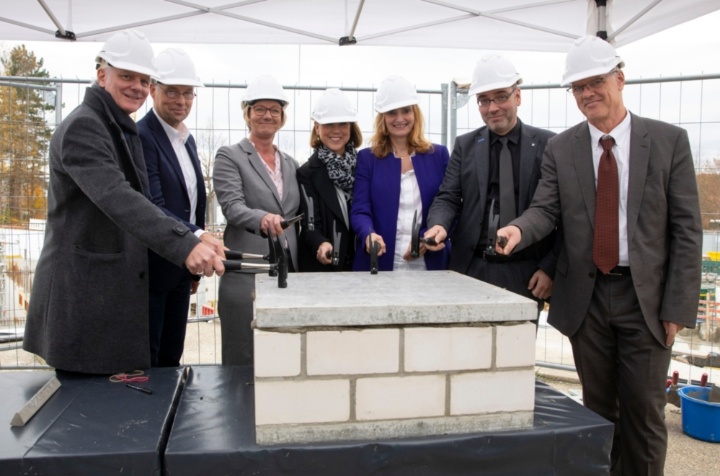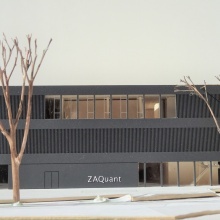"A pioneering investment in the technology of the future”, was how Jan Gerken, Chancellor at the University of Stuttgart, described the building work for the ZAQuant building, the new Center for Applied Quantum Technology. After preparatory excavation work during the course of the year, the foundation stone for the new building, which is due to house a precision laboratory and an office wing, was laid on November 12, 2018 at the site at Allmandring 13.
At the new center, research will be carried out into quantum sensor technology across different faculties and disciplines. Scientists at the university are set to advance the state of research into quantum technology in Germany at the new center, along with representatives from industry. The main purpose is to develop nanophotonic quantum sensors using quantum technology, and in so doing make sensors more sensitive and energy efficient. For this to happen, the sensors need to use the principles of quantum physics and nanophotonics and combine them together. They form the basis for further technological advances, for example in medicine, communications, and also in mobility.
“With cutting-edge research, we are securing Baden-Württemberg’s reputation in the field of advanced technology”, said Petra Olschowski, State Secretary for Science, Research and the Arts. “We will see some interesting developments in the next few decades, which by using quantum effects will bring about advances which previously have not even been imagined, for example in communications and measurement technology. This therefore makes ZAQuant a valuable contribution towards ensuring that Baden-Württemberg remains competitive in the field of advanced technology”.
Jan Gerken, Chancellor at the University of Stuttgart, used his welcoming address to emphasize the significance that the Center for Quantum Technology has for the strategic orientation of the University of Stuttgart on its path towards becoming a globally recognized research university. “The interdisciplinary approach to research pursued at the ZAQuant is internationally unique, and will tackle the challenges of the second quantum revolution successfully and lay the groundwork for the findings to be applied.”
At the laying of the foundation stone, the Mayor of Stuttgart Isabel Fezer said “A piece of the future is being created here. This building will become a new gem in Stuttgart’s attractive array of higher-education providers. The foundations are being laid for pioneering research. What young people and experienced scientists will develop here in future will be good for businesses in the area. I am sure that you will attract committed researchers to Stuttgart, who will work towards making our city fit for the future. I hope that the rest of the building work goes well and that you will be able to hit the ground running in 2020.”
The Director of the Institute for Theoretical Physics III at the University of Stuttgart, Prof. Jörg Wrachtrup, lastly emphasized that ZAQuant will become home to a number of working groups from the fields of quantum optics, atomic and solid state quantum physics, mechanical engineering as well as electronic and manufacturing technology, who will work together towards one research goal. “This is because life at ZAQuant will revolve around working together across disciplines, communicating with each other and scientific and personal exchange, which are key factors for scientific success”, says Wrachtrup.

Areas of research at ZAQuant
The research building will bring together research into quantum sensors from various disciplines, from basic physics research to electrical engineering, and will provide the infrastructure required for research into quantum sensor materials as well as precision measuring of quantum sensors. Alongside the new scientific content, a core aspect of the research plans is to encourage collaboration between departments. The research work is divided into three areas of research.
Research area 1 is dedicated to the core elements of future quantum sensors which determine the values being measured. This should promote the synthesis of ultrapure specific sensor materials, e.g. diamond or silicon carbide, in a laboratory in ZAQuant set up specially for synthesizing ultrapure quantum materials.
Research area 2 will explore new physical methods for controlling or recording the signals of the active sensor elements which have recently been developed with regard to integrating them. Because most new quantum sensors are read optically, the well-known methods for controlling electronic components, which are mostly used with traditional sensors, cannot be used. Instead, an optical periphery for quantum sensors which can be integrated, meaning one that can be miniaturized, needs to be developed. This should be done in a newly-built laboratory for precision structuring of quantum materials.
In research area 3, this should then be integrated into devices, along with the periphery which has been developed and the different quantum sensor elements. There are two objectives behind integrating the sensors. Firstly, conducting research into the necessary integration and assembly technology should serve to advance the development of compact and robust quantum sensors. Secondly, different types of quantum sensors should be combined, to make some of their applications at all possible.


